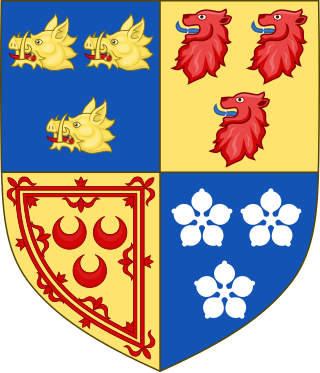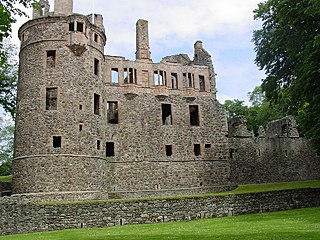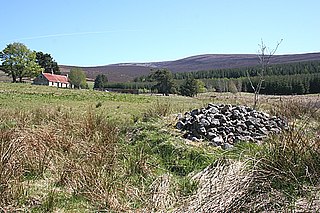| |||||
| Centuries: | |||||
|---|---|---|---|---|---|
| Decades: | |||||
| See also: | List of years in Scotland Timeline of Scottish history 1594 in: England • Elsewhere | ||||
Events from the year 1594 in the Kingdom of Scotland .
| |||||
| Centuries: | |||||
|---|---|---|---|---|---|
| Decades: | |||||
| See also: | List of years in Scotland Timeline of Scottish history 1594 in: England • Elsewhere | ||||
Events from the year 1594 in the Kingdom of Scotland .

Clan Campbell is a Highland Scottish clan, historically one of the largest and most powerful of the Highland clans. The Clan Campbell lands are in Argyll and within their lands lies Ben Cruachan. The chief of the clan became Earl of Argyll and later Duke of Argyll.

George Gordon, 1st Marquess of Huntly was a Scottish nobleman who took a leading role in the political and military life of Scotland in the late 16th century, and around the time of the Union of the Crowns.

Huntly Castle is a ruined castle north of Huntly in Aberdeenshire, Scotland, where the rivers Deveron and Bogie meet. It was the ancestral home of the chief of Clan Gordon, Earl of Huntly. There have been four castles built on the site that have been referred to as Huntly Castle, Strathbogie Castle or Peel of Strathbogie.
Archibald Campbell, 7th Earl of Argyll, also called "Gillesbuig Grumach", was a Scottish peer, politician, and military leader.

Glenlivet is a glen in the Highlands of Scotland through which the River Livet flows.

William Douglas, 10th Earl of Angus was a Scottish nobleman. He was the son of William Douglas, 9th Earl of Angus (1533–1591). He was a direct descendant of King James I through his paternal grandmother, Agnes Keith, a daughter of William Keith, 3rd Earl Marischal.

Tomintoul is a village in the Moray council area of Scotland in the historic county of Banffshire.

Clan Gordon is a Highland Scottish clan, historically one of the most powerful Scottish clans. The Gordon lands once spanned a large territory across the Highlands. Presently, Gordon is seated at Aboyne Castle, Aberdeenshire. The Chief of the clan is the Earl of Huntly, later the Marquess of Huntly.
Bonnie James Campbell or Bonnie George Campbell is Child ballad 210. The ballad tells of a man who has gone off to fight, but only his horse returns. The name differs across variants. Several names have been suggested as the inspiration of the ballad: Archibald or James Campbell, in the Battle of Glenlivet, or Sir John Campbell of Calder, who was murdered.

The Battle of Glenlivet was a Scottish clan battle fought on 3 October 1594 near Glenlivet, Moray, Scotland. It was fought between Protestant forces loyal to King James VI of Scotland who were commanded by Archibald Campbell, 7th Earl of Argyll, against Catholic forces who were commanded by George Gordon, 6th Earl of Huntly, and Francis Hay, 9th Earl of Erroll. The Catholics won a decisive victory in the battle, but in the aftermath were subdued by King James.

Agnes Douglas, Countess of Argyll was a Scottish noblewoman and the first wife of Archibald Campbell, 7th Earl of Argyll. She was the mother of three of his children, including his heir, Archibald Campbell, 1st Marquess of Argyll, the de facto head of the government in Scotland throughout most of the conflict known as the Wars of the Three Kingdoms. Lady Agnes was considered so beautiful that she was described as a "pearl of Lochleven."

The Campbell of Auchinbreck family was founded by Duncan Campbell in Glassary, Argyll, Scotland. He was the son of Lord Duncan Campbell, first Lord Campbell of the Clan Campbell, by his second wife Margaret, daughter of Sir John Stewart of Blackhall, the illegitimate son of King Robert III of Scotland. The family of the Lords Campbell later became Dukes of Argyll, and remain chiefs of Clan Campbell. Duncan Campbell, as a grandson of King Robert III, received a considerable estate confirmed by royal charter dated 19 June 1452. The family remained at their estate of Auchinbreck, from which they took their title, until 1641. The Campbells of Auchinbreck were commissioned to provide military training and were used by the Earls of Argyll as military support. In 1628 the then head of the family of Campbells in Auchinbreck received a baronetcy, which included a grant of North American land in Nova Scotia.

Slains Castle is a ruined castle near Collieston in Aberdeenshire, Scotland. It is not to be confused with New Slains Castle, a separate building located five miles northeast. Built in the 13th century, it was partly destroyed in 1594.
Events from the year 1592 in the Kingdom of Scotland.
Events from the year 1578 in the Kingdom of Scotland.
Sir Walter Lindsay of Balgavie was a Scottish Roman Catholic intriguer.

Charles Kirkpatrick Sharpe was a Scottish antiquary and artist.

James Scott of Balwearie was a Scottish landowner and supporter of the rebel earls.

Patrick Gordon of Auchindoun (1538–1594) was a Scottish landowner and rebel.
Lachlan Mor Mackintosh, 16th of Mackintosh was the chief of the Clan Mackintosh, a Scottish clan of the Scottish Highlands. He was also chief of the confederation of clans that was known as the Clan Chattan.